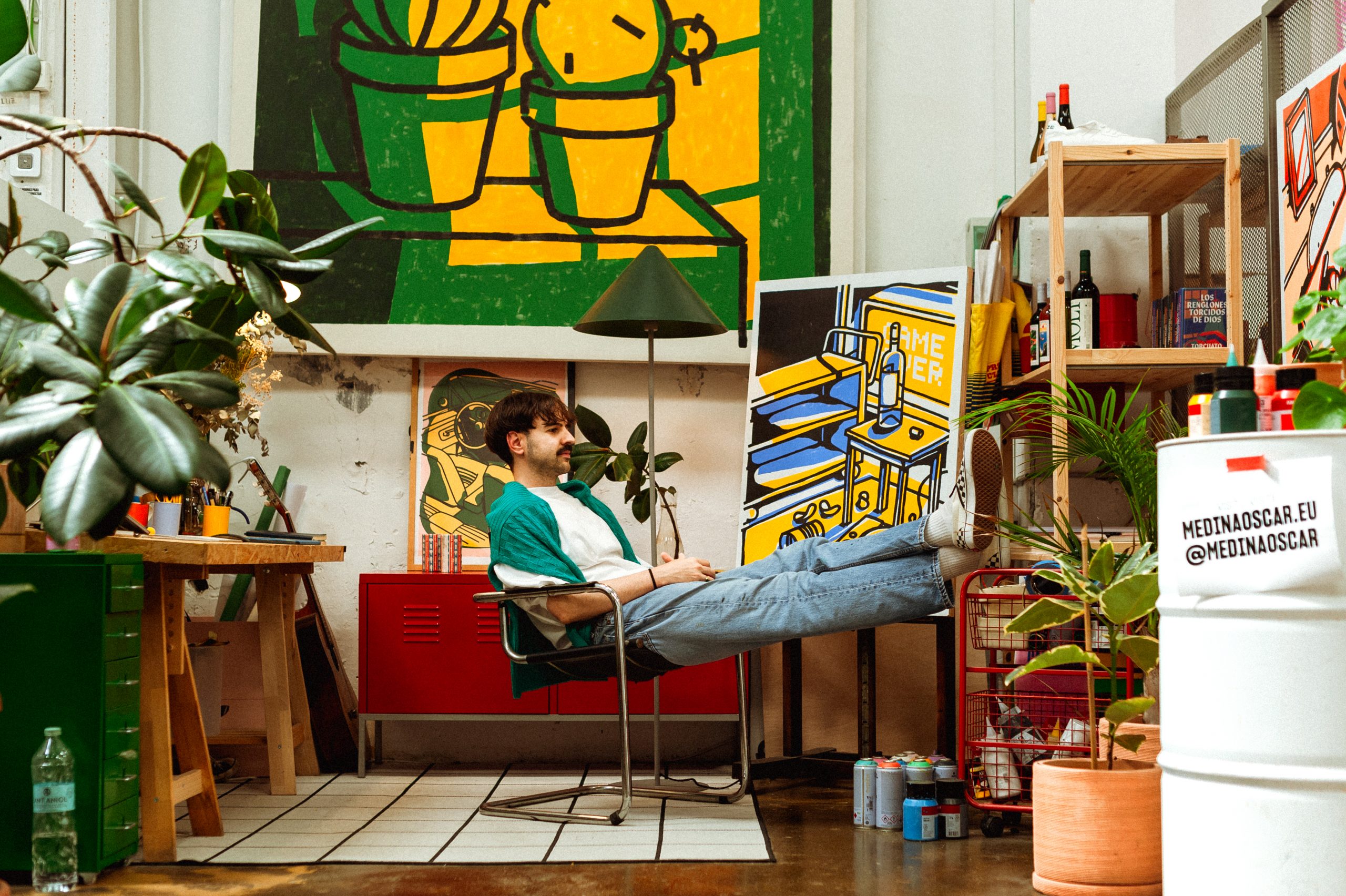
For Barcelona-born ‘visual expressionist’ Oscar Medina, creating a 360° sensory universe is an impulse that started long before it formalised as an artistic practice – he recalls ‘art directing’ his daily life as a child. “I have been doing this since I can remember,” he says, “I just needed to learn how to channel it.” With work that spans illustration, design, garments and ‘live paintings’, Oscar’s creative touch is all-encompassing and instantly recognisable, without losing its signature emotional quality, no matter the medium. His tees with playful slogans such as ‘Mellow Scenes‘ and ‘Barcelona Ninetees‘ are some of our most popular designs – here, Oscar tells us about what inspires him, working across mediums and finding your signature style by experimenting with your pleasures and weaknesses.
You describe yourself as a ‘visual expressionist’. What’s your background and how did you get started as an artist?
Visual expressionism came from my need to find a concept that defines both my work and myself, as they are intertwined. I wanted to show the subjective gaze of my inner world. The need to express myself and create atmospheres of sensitive content connects everything I create, whether it’s painting, writing, animation, design, fashion or illustration.
My interest in art and culture comes from a fierce need to express myself that started long before I had a framework of cultural beliefs. As a child, I had a fixation on the aesthetics of my surroundings, and even back then I was creating ‘art direction’ for my daily life. For me, design, illustration, or painting are tools to materialise universes. I have been doing this since I can remember, I just needed to learn how to channel it.

Photos by @bonastre.photo
What’s your design process like? How do you move in between disciplines?
The methodology that became integral to my practice during my design studies forces me to find a formal conclusion in advance for what I want to create. I love working on 360 projects where I design the typography and illustration, or where I can direct the image of the brand. I really enjoy creating entire narratives.
When it comes to inspiration, I believe I am a product of everything that comes after Matisse in terms of formality, but I also identify with Edward Hopper in what I aim to evoke in my work. In terms of discourse, I feel aligned with the popular, the everyday, and the breaking of dogmas and established beliefs. If I could form a family with the painters I feel the closest connection to, it would include Giorgio de Chirico (for his harsh shadows and surreal landscapes), Kenton Nelson (for the sweetness of his lights, shadows, and brushstrokes), and John Register (for the solitude and contemplation I perceive in his scenes).
But I also find inspiration in reading authors such as Jorge Luis Borges or Julio Cortázar, plus some classical philosophers. Then there’s cinema, which sculpts my imaginary model of beauty. Not to mention music – without John Coltrane’s mellow saxophone or the hidden melody in Billie Holiday’s “I’ll Look Around,” I wouldn’t be able to build and convey my idyllic planet.
My art is driven by everything that nourishes my soul: memories, images, sounds, and scents that generate a sensory universe. I aim to create dreamlike scenes that transport you to a place you may or may not have been before, but that are able to generate a sense of nostalgia.
You work across different mediums, from creating ‘live paintings’ to designing for garments. How do you make sure you’re engaging your audience in each of these different mediums?
After many years of searching, I believe I have managed to develop a unique language and a consistent style that we could even call a “personal brand”. The medium does not matter, but each application requires slight changes in my role.
How has working with Everpress helped evolve your practice? What did you learn from the process?
Everpress has helped me save time – the only thing you can’t buy – allowing me to focus on generating ideas and bringing them to life without worrying about the production. Furthermore, Everpress has provided me with a gateway to the world. It has taught me that there are battles best left to platforms that are already prepared for that job. But above all, what it has proved to me is that a big project can have a wonderful team of kind people behind it who are willing to help.
What would your advice be to other artists/designers who want to get started designing for garments?
I would tell them to look for role models within themselves. I would tell them to ask themselves what they like and enjoy, and what their weaknesses are. We are social animals and we are way more alike than we think. You will always find a community that will understand and relate to what you have to share.
Explore our Creator Toolkit to learn more about the process behind our most successful designs, from making the jump from architecture to visual design with Alexander Khabbazi to finding your signature style with Grace Kao.


